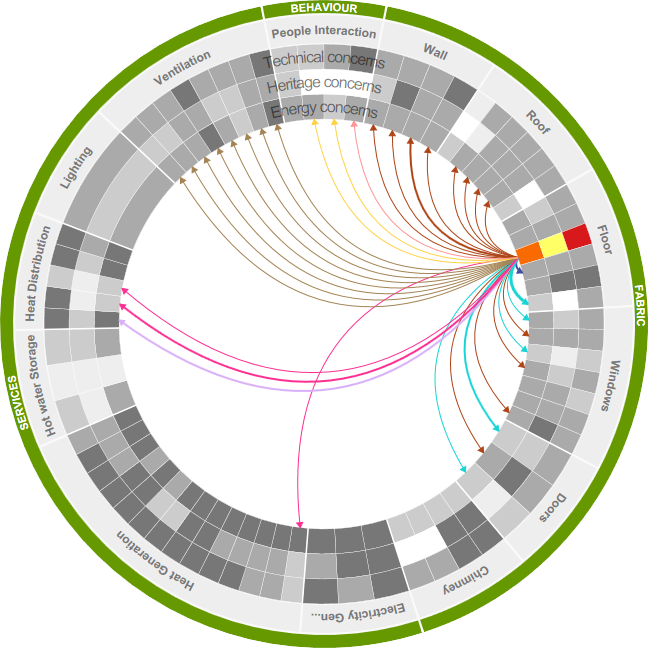Concern & action: Overheating
High temperatures in buildings can cause discomfort and ill health. Fabric energy efficiency measures can exacerbate problems (e.g. by changing thermal mass, increasing thermal resistance and reducing ventilation). Services can also increase heat loads.
Suggested actions
Before Implementation
Carry out in situ tests to establish whole building performance (e.g. U-value measurement, room conditioning monitoring, air pressure test). Use these in situ measurements to inform whole building energy numerical modelling (i.e. IES, Energy Plus etc), making a thorough assessment of all factors contributing to year round internal temperatures. Consider strategy for building to deal with higher temperatures (e.g. shading, thermal mass, purge night ventilation, planting). Ensure effective ventilation is possible, i.e. cross ventilation, and check that existing window opening and shading opportunities are not compromised by additional measures. Beware that personal preference may override optimum settings for system. Decide on operation strategy and balance the need for good user understanding and automation of the system. Consider automation may be best for higher risk levels.
During implementation
Communicate the strategy to minimise overheating to occupants clear and simply and check they understand it. Beware of personal preferences that may override optimum system settings.
After implementation
Monitor and report temperature conditions experienced post refurbishment.
RELATED MEASURES
 FABRIC (27)
FABRIC (27)
External Wall insulation
Internal Wall insulation
Frame infill insulation
Loft insulation
Rafter insulation
Flat roof insulation
Room in roof insulation
Loft hatch and ceiling airtightness
Floor insulation between/under floor joists
Floor Insulation on top of existing floor finish
Floor void filled with insulation
Replacement of existing ground floor with new concrete insulated solid ground floor
Increased Floor airtightness
Window draughtproofing
Energy efficient glazing
Window refurbishment
Secondary glazing
Window Shutters Refurbishment
Window Replacement
Door draughtproofing
High performance doors
Door refurbishment
Chimney removal complete
Chimney removal internal
Chimney blocking
Reduced air flow
 SERVICES (1)
SERVICES (1)
RELATED REFERENCES (7)
Resilience of ‘Nightingale’ hospital wards in a changing climate (2012)
Lomas, K.J., Giridharan, R., Short, C.A. and Fair, A.J.
Energy Efficiency In Historic Buildings -Secondary glazing for windows (2010)
English Heritage
Will drivers for home energy efficiency harm occupant health? (2010)
Bone, A., Murray, V. Myers, I., Dengel, A. and Crump, D.
The usability of control interfaces in low-carbon housing, Architectural Science Review, 56:1, 70-82 ( 2013)
Stevenson F, Carmona-Andreu I and Hancock M
Ranking of interventions to reduce dwelling overheating during heat waves (2012)
Porritt, S.M.; Cropper, P.C.; Shao, L. and Goodier, C.I.
Findings from a Post Occupancy Evaluation of adaptive restoration and performance enhancement of a 19th century (2011)
Sharpe, T. and Shearer, D.
Conversion of Traditional Buildings Part 2 - sections 3 Enviroment & 6 Energy (2007)
Ed. Dennis Urquhart, Historic Scotland

